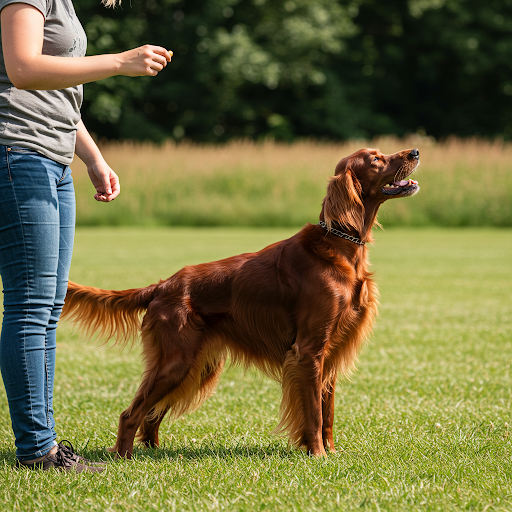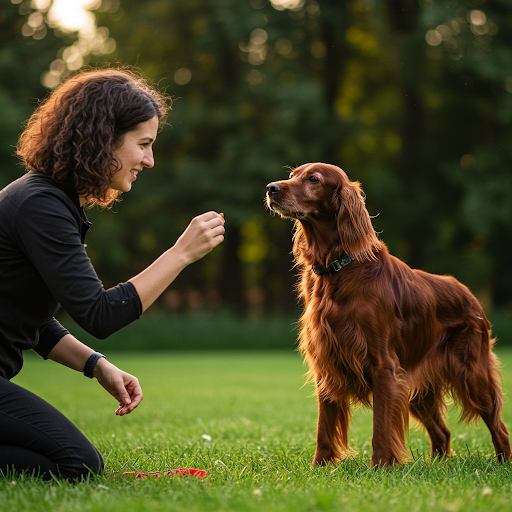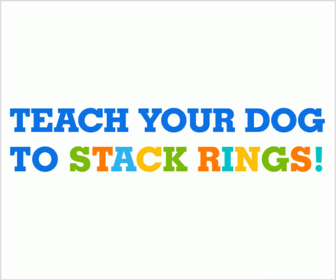Irish Setters captivate with their spirited nature and elegant bearing. The Irish Setter breed is known for its lively temperament, requiring dedicated care, training, and attention to its unique characteristics. Originating from the lush, rolling hills of Ireland, these medium to large-sized gun dogs exude an unmistakable charm accentuated by their deep red or mahogany coats. Their playful demeanor and inexhaustible zest make them delightful companions for active families who relish outdoor adventures. Yet beneath their exuberance lies a need for regular exercise, meticulous grooming, and consistent training. Mastering Irish Setter basic commands is essential to channel their energy and intelligence effectively. Their beauty is not merely skin-deep; it is interwoven with a robust intellect and a propensity for joy that flourishes when their environment nurtures both body and mind.
Table of Contents
Understanding Your Irish Setter’s Personality
Irish Setters are known for their friendly, outgoing, and energetic personalities. These dogs thrive on human interaction and attention, making them excellent companions for active families. Their intelligence and eagerness to please make them highly responsive to positive reinforcement training methods. However, their independent streak can sometimes lead to stubbornness, requiring patient and consistent training.

Irish Setters are natural people-pleasers and form close bonds with their owners, often earning the nickname “velcro dogs” due to their tendency to stick close by. This strong attachment can sometimes lead to separation anxiety if not addressed early on. Early training and socialization are crucial in helping your Irish Setter develop good coping mechanisms and reducing the risk of anxiety-related behaviors. By understanding your Irish Setter’s personality, you can tailor your training approach to foster a strong bond and effective communication.
Why Training is Important for Irish Setters
Training an Irish Setter is not simply about teaching commands—it is about fostering mutual understanding and trust. Establishing early expectations through training can mitigate the development of undesirable habits and ensure a harmonious relationship. This process builds an unspoken bond that strengthens with each shared moment of learning and play. Given their keen intelligence and eager-to-please disposition, Irish Setters respond remarkably well to these positive reinforcement methods. Engaging in formal training further refines their natural abilities, transforming them into well-mannered companions who can seamlessly integrate into any social setting.
The foundation of effective training begins with basic commands. The command “sit” is a versatile tool that captures a dog’s attention and channels its energy into calm focus. Most dogs learn the “sit” command first and enjoy the process of learning. It is often one of the first commands an Irish Setter puppy learns, setting the stage for further instruction. The command “stay” is indispensable, especially when managing transitions in environments such as entering or exiting a home or navigating busy public spaces. “Come” is critical for off-leash excursions and reliable recall, ensuring that your Setter remains within your sphere of control. Equally important is the “leave it” command, which teaches the dog to disregard distractions and refrain from engaging with unwanted objects. The command “heel” directs the dog to maintain a disciplined gait on a leash, preventing pulling and fostering a synchronized walking pace. Each of these commands lays the groundwork for a responsive and well-adjusted pet.
Socialization is an integral facet of training that broadens an Irish Setter’s perspective and fortifies its adaptability. It begins early—ideally from eight weeks of age—when exposure to diverse environments, people, and animals can profoundly shape the dog’s social comportment. By venturing into parks, dog-friendly public spaces, and pet stores, your Setter gradually becomes accustomed to a kaleidoscope of stimuli, which in turn diminishes timidity and anxiety. Regular encounters with strangers—from dog owners to jubilant children to elderly individuals—nurture a sense of comfort around new faces, while interactions with other animals encourage amicable behavior and reduce potential aggression. Consistent use of positive reinforcement, whether through treats or enthusiastic praise, transforms every encounter into an opportunity to consolidate calm and friendly conduct.

The right ensemble of training tools and equipment can significantly enhance the training and house- process for an Irish Setter. A robust leash and a well-fitted collar provide the primary means to manage and direct your dog’s movements. For those Setters with a tendency to pull, a harness offers a gentler alternative by distributing pressure across the chest and shoulders. Clickers, with their distinct auditory signal, serve as precise markers that denote correct behavior when paired with high-value treats. Such treats not only motivate but also reward desirable actions, reinforcing positive patterns. During the early stages of housebreaking, training pads create a designated space that simplifies the transition to outdoor routines. Each of these tools, when used judiciously, contributes to a training regimen that is both effective and enjoyable.
Creating a Training Schedule
Creating a training schedule is essential to ensure that your Irish Setter receives consistent and effective training. A well-structured training schedule helps establish a routine, set clear goals, and track progress. It’s important to tailor your training schedule to your Irish Setter’s age, breed, and individual needs.
When creating a training schedule, consider the following factors:
Age: Puppies require more frequent and shorter training sessions, while adult dogs can handle longer and more intense training sessions.
Breed: Irish Setters are highly energetic and require regular exercise and mental stimulation.
Individual Needs: Consider your Irish Setter’s unique personality, strengths, and weaknesses when developing a training schedule.
A typical training schedule for an Irish Setter may include:
Daily Training Sessions: 2-3 short sessions (10-15 minutes) focusing on basic obedience, agility, and socialization.
Weekly Training Sessions: 1-2 longer sessions (30-60 minutes) focusing on advanced training, problem-solving, and reinforcement of previously learned behaviors.
Monthly Training Sessions: 1-2 sessions (60-90 minutes) focusing on specialized training, such as agility, obedience, or hunting.
By adhering to a consistent training schedule, you can ensure that your Irish Setter remains engaged, motivated, and well-behaved.
Training Irish Setters: Basic Commands
Basic commands are the foundation of any successful dog training program. Irish Setters are highly intelligent and respond well to positive reinforcement training methods. Here are three essential basic commands to get you started:
Sit
The “sit” command is one of the most basic and essential commands for any dog. It’s a great way to establish a calm and focused state, making it easier to train your Irish Setter.
To train your Irish Setter to sit:
Hold a treat in front of your Irish Setter’s nose.
Slowly move the treat upwards and backwards, towards their tail.
As they follow the treat with their head, their bottom will lower into a sitting position.
Once they’re in the sit position, say “sit” and give them the treat.
Repeat this process several times, gradually increasing the duration of the sit.
Stay
The “stay” command is a natural progression from the “sit” command. It helps to establish trust and authority, while also providing a safe and calm state for your Irish Setter.
To train your Irish Setter to stay:
Start by having your Irish Setter sit or lie down.
Take a few steps back and say “stay.”
If they get up, go back to the beginning and try again.
Gradually increase the distance and duration of the stay.
Reward your Irish Setter with treats and praise when they successfully complete the stay.
Come
The “come” command is essential for off-leash training and ensuring your Irish Setter’s safety. It’s a challenging command, but with patience and consistency, your Irish Setter can learn to respond reliably.
To train your Irish Setter to come:
Start in a controlled environment, such as a fenced area or a room.
Call your Irish Setter’s name and say “come.”
Use positive reinforcement, such as treats and praise, to encourage them to come to you.
Gradually increase the distance and distractions, while maintaining a consistent recall.
Reward your Irish Setter with treats and praise when they successfully complete the come command.
By mastering these basic commands, you can lay a strong foundation for your Irish Setter’s training and ensure they become a well-behaved and obedient companion.

Advanced Training Techniques
Beyond the rudimentary commands of basic obedience, Irish Setters flourish with advanced training techniques that challenge both their minds and bodies. Agility training, for example, not only refines their physical coordination but also hones their problem-solving capabilities. Obedience training deepens the communication between handler and dog, allowing commands like “stay” to be employed in diverse contexts—from competitive sports to everyday scenarios. These advanced exercises inject mental stimulation and physical exertion into your Setter’s routine, mitigating boredom and preempting destructive behavior. Furthermore, the intricacy of advanced training strengthens the emotional connection, ensuring that every session becomes a testament to your shared journey toward excellence.
Effective Training Sessions
Effective training sessions are characterized by brevity, enthusiasm, and consistency. Short bursts of focused training, typically lasting between five to ten minutes, are ideal for maintaining your Irish Setter’s attention. Integrating positive reinforcement techniques—such as generous verbal praise and enticing treats—creates a dynamic learning atmosphere that is both enjoyable and productive. Consistency in commands and reward systems is paramount; fluctuating approaches can confound your dog and hinder progress. Concluding each session on an upbeat note not only solidifies learned behaviors but also cultivates an eagerness to participate in future training endeavors. Regular, engaging sessions pave the way for lasting behavioral improvements and a resilient, affectionate bond.
Tips for Training Irish Setters
Initiating training at an early age lays the foundation for lifelong obedience and good manners. A profound understanding of canine behavior is indispensable; it enables the trainer to anticipate challenges and tailor approaches to suit the dog’s unique temperament. Employing positive reinforcement, rather than punitive measures, fosters an environment where good dog behavior itself is naturally encouraged. Patience and persistence are virtues in training, especially when navigating the occasional stubborn streak inherent in Irish Setters. Infusing sessions with fun, varied activities keeps your dog motivated, ensuring that training is perceived as a delightful adventure rather than a chore.
Common Challenges and Solutions
Irish Setters, while inherently intelligent, can occasionally exhibit behavioral challenges such as incessant barking or howling. Maintaining training progress is crucial to avoid behavioral issues that can arise from ineffective training techniques. These tendencies may stem from boredom or an excess of unchanneled energy. Positive reinforcement remains the most effective tool for addressing such issues, coupled with ample exercise and mental stimulation. Mastery of basic commands is essential not only for discipline but also for safeguarding your dog in unpredictable environments. In moments of distraction, techniques like the “touch” command can effectively recapture your Setter’s attention, realigning its focus on the task at hand. Addressing these challenges with a balanced approach generally ensures a harmonious coexistence and robust behavioral foundation.
Nutritional Impact on Training
The symbiosis between nutrition and training is undeniable. A high-quality diet, replete with proteins, healthy fats, and complex carbohydrates, fuels your Irish Setter’s energy and concentration during training sessions. Foods laden with fillers and by-products can undermine focus and even precipitate digestive disturbances. Adequate hydration is crucial; a well-hydrated dog is more agile and attentive. Equally important is the regulation of portion sizes to prevent lethargy associated with overfeeding. Supplements, such as omega-3 fatty acids and probiotics, may further enhance cognitive function and mitigate anxiety. Optimizing your dog’s nutritional intake creates a fertile ground for effective learning and enduring vitality.
Maintaining Progress and Health
Sustaining the progress achieved in training requires continuous physical activity and mental engagement. Mastering basic commands is crucial for keeping the dog safe in various environments. Regular exercise, tailored to your Irish Setter’s exuberant nature, complements the training process and fortifies your dog sports overall health. A balanced diet, alongside routine veterinary examinations, ensures that your dog remains in peak condition. Ongoing training and socialization not only prevent the resurgence of behavioral issues but also stave off boredom, which can lead to destructive conduct. The commitment to a comprehensive care routine is the cornerstone of maintaining both progress and long-term well-being.
Conclusion – Irish Setter Basic Commands
Training an Irish Setter is an evolving journey that demands dedication, consistency, and an abundance of affection. With the appropriate techniques and a steadfast, positive approach, your Irish Setter will flourish into a well-behaved, loyal companion who enhances every aspect of family life. Prioritizing your dog’s health, well-being, and continual learning ensures that the bond you share is both profound and enduring. Embrace the training process as an opportunity to cultivate trust, enrich communication, and celebrate the distinctive brilliance of your Irish Setter.















